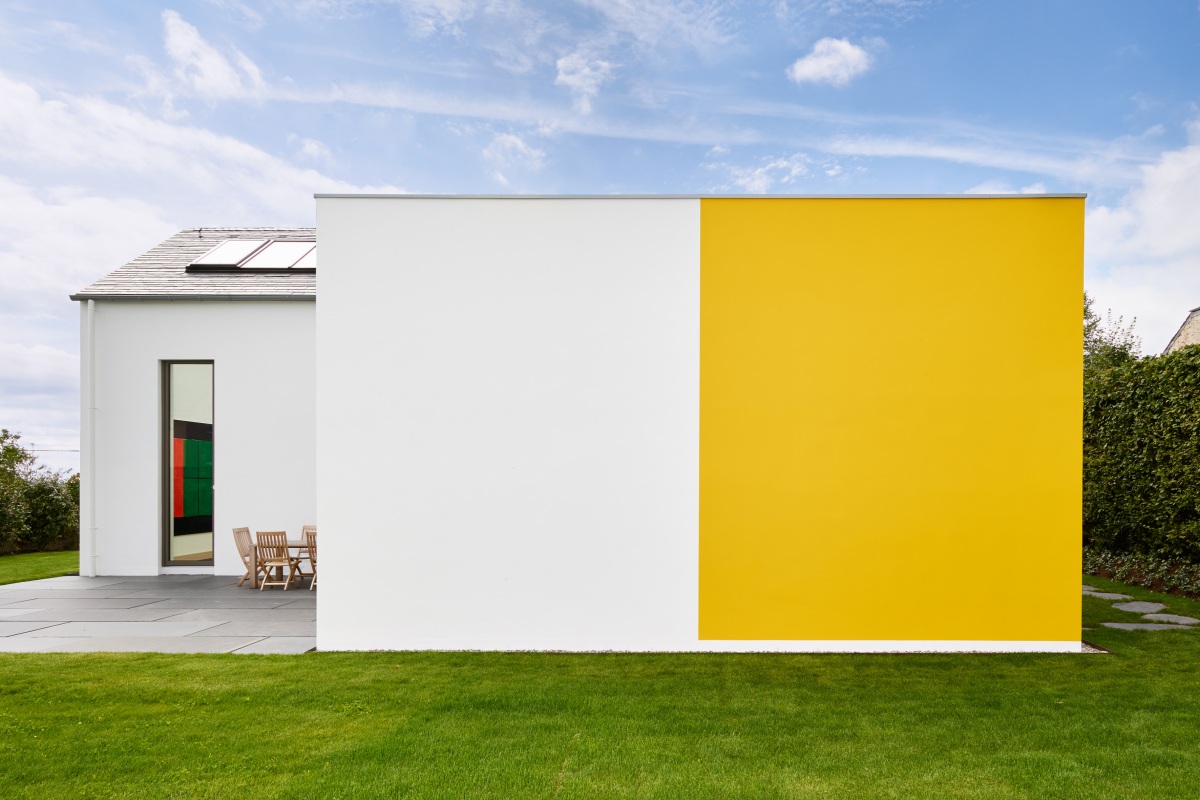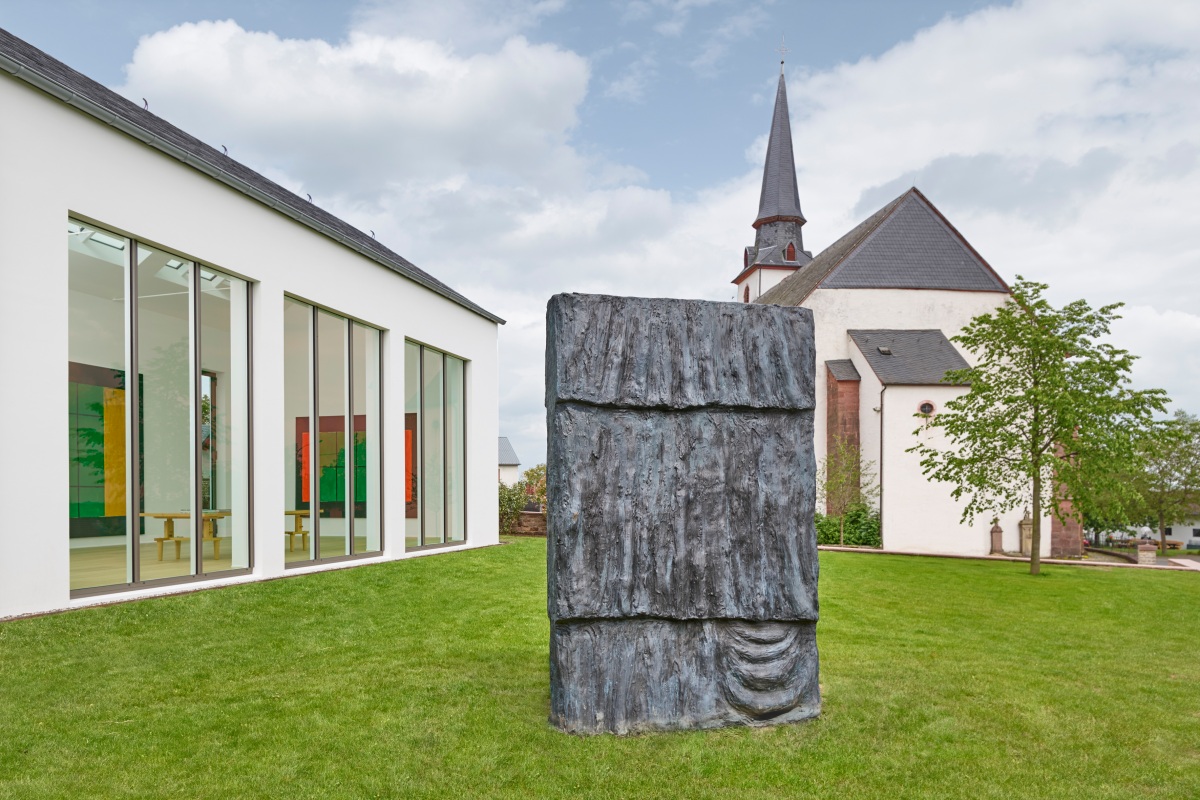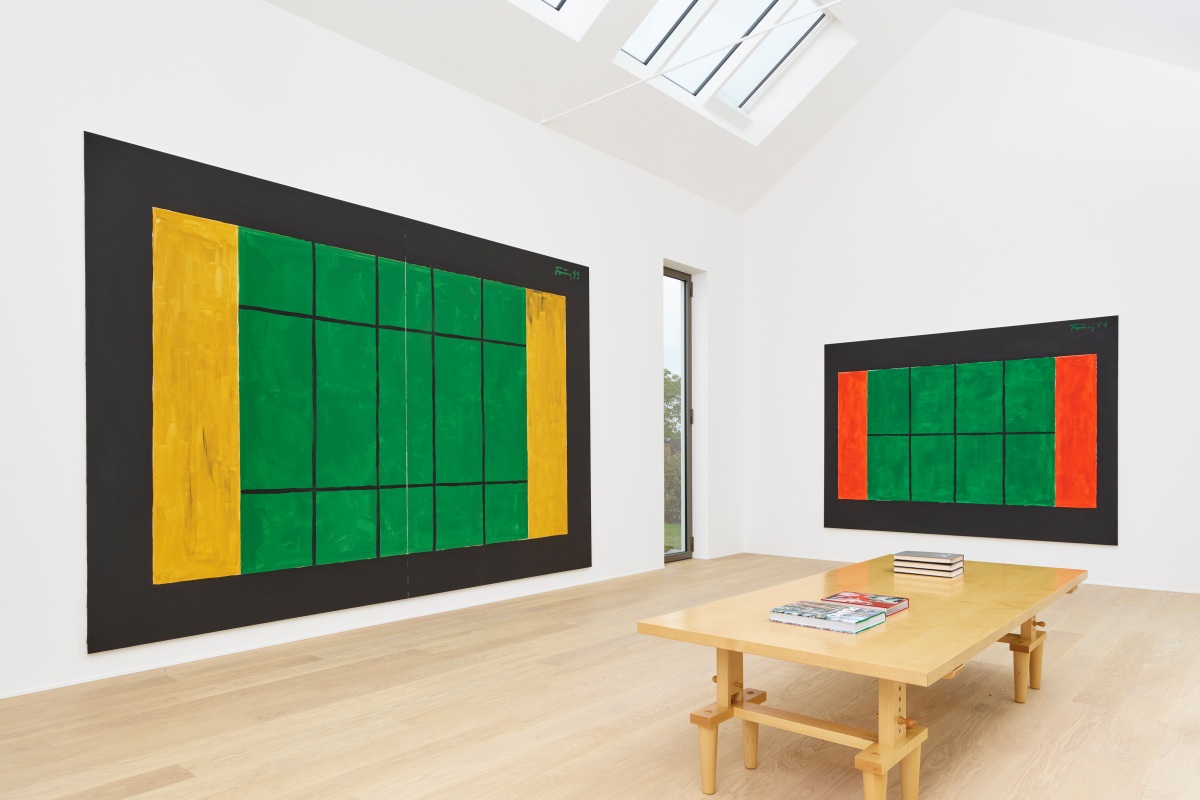Bibliothek Günther Förg
Hauptstraße 7, 54636 Weidingen
Günther Förg has built three libraries in his studios and apartments in Switzerland and Germany. The Stiftung zur Förderung zeitgenössischer Kunst in Weidingen (Foundation for the Promotion of Contemporary Art in Weidingen) acquired one of these libraries with approximately 3000 books.
This library will be open for study purposes all year round, by appointment. It is located in a new building, complementing the sculpture garden, guest house and the exhibition space of the Foundation.
The building, as well as the exhibition space and the guest house of the Foundation, is designed by the Trier office, Axt Architekten. It is situated in the old inner part of Weidingen, directly adjacent to the parish church: Church of the Immaculate Conception of Mary. It is a simple and reduced structure based on the architectural tradition of the region.
With an impressive ceiling height of 4 meters, the new building is divided in two parts: the exhibition space and the library.
The central exhibition space comprises a self-contained volume with three walls displaying paintings by Günther Förg, with day light from a large window and skylight. The lateral panorama window offers beautiful views of the neighbouring church. Moreover, the outer wall of the library will provide a view on a Förg wall painting.
Günther Förg (1952–2013)
‘What others take for granted is a problem for us’ – this rough translation of a title chosen by Günther Förg for his exhibition at the Museum Abteiberg Mönchengladbach in 1998 could also work as a leitmotif for Günther Förg himself. He borrowed the idea from the song cycle Journey through the Austrian Alps by Austrian composer Ernst Krenek, who later emigrated to the United States. In his squeaky voice Förg sang to me the first lines of the songs; for the private exhibition view in the museum’s conference hall a baritone from Vienna performed the cycle accompanied by a piano. The show consisted of new works in which Förg almost ironically addressed the avant-garde, quoting from his own grid paintings. In the main exhibition hall, designed by Hans Hollein, he hung the huge painting Die große Decke (The Large Blanket), in which he offered an apology for both constructivism and his own grids in a kind of apotheosis flanked by two I-motives lifted from Munch’s paintings of moonlight. Günther Förg’s exhibition highlighted both the inner turmoil of 20th-century painting and the artist’s own. In Krenek’s composition, the title borrowed by Förg was prefaced by another sentence: ‘Disbelief towards ourselves is deeply rooted within us, what others take for granted is a problem for us.’ The core of the sentence can be inverted: what is a problem for others we take for granted. We do not fill the day with rituals of our social conventions, but with our own standards that others may find problematic. This is the kind of person Günther Förg was. On the surface, to his critics and at times even to his artist friend Martin Kippenberger, he often seemed to be a conservative painter. Yet beneath that guise lurked the radical Förg, whose combinations of materials and colours shattered the image of painting held by the preceding generation of Richter, Polke, Baselitz and Palermo.
Before I personally got to know Günther Förg I saw riveting works by him. The first was the unforgettable photograph Monika mit Chinesenhut (Monika with a Chinese Hat) at Büro Orange, the Siemens office in Munich in 1982, which showed a girlfriend of Günther with a kind of lampshade on her head. It was mounted on an aluminium panel, combined with the carpet below and a wall painting. Förg himself was confined to a hospital bed after falling down the stairs and suffering a concussion. Then came a coincidental and rather unspectacular encounter at the gallery and in the presence of Rüdiger Schöttle at Martiusstraße in Schwabing, Munich. A quiet Förg, who smiled and said little.
I was sure I wanted to exhibit this strikingly talented man. But how and when? I shied away from visiting him. Then, at Peter Pakesch’s gallery in Vienna, I saw reliefs out of concrete with scratchy textures and large signatures that confronted me with a monstrous Förg who unsettled me. And in 1984 at the opening of Jörg Johnen’s gallery in Cologne he arrived late. With a sardonic smile, he stuffed a lettuce leaf from the buffet into my jacket’s breast pocket, commenting that I had forgotten the pocket square.
Günther the monster, whom I then witnessed at private views where he screamed at his friends, such as Jean-Christophe Ammann or Michael Tacke, then kissed and ruffled their hair or goofed around under the restaurant table, all this I found quite amusing. Similar to my two other artist friends of the 1990s, Martin Kippenberger and Franz West, these grotesque attitudes were an expression of just how different they were – especially given the in-crowd conventions of private views, gathering an audience they needed yet despised for being so superficial. When I later visited him in his Swiss residence in Areuse, I was to meet a Günther Förg who owned extremely interesting books on art theory, film theory, not to mention philosophy and psychology, which were lying around alongside CDs of classical music as well as a CD by fado singer Amália Rodrigues, something that personally connected us. The exceptional level of reflection within his art was interspersed with fierce spontaneity, burlesque notions and seemingly trivial effects that burst any intellectual reception. Thus he preserved the directness and freshness of his ideas.
Being director of the Fridericianum in Kassel, in 1990 I finally had the opportunity to prepare a really big exhibition of Günther’s work – a demonstration of his skills that travelled on to Leipzig, Ghent and Tübingen. He masterfully linked massive lead and copper works with photos of Italian architecture by Terragni and other Rationalist architects, bronze reliefs and sculptures as well as an unforgettable wall full of gouaches on Canson paper, which floated in boxes under glass. In retrospect, I remember everything in this staged room as being a kind of archaic treasure chamber like King Agamemnon’s. But this treasure was alive, among the fascist architectures of modernism hung the portrait of his wife Ika behind reflecting glass. A journalist, later an influential figure in the cultural scene of North Rhine-Westphalia, told me she thought that Günther Förg had herewith bombed himself into oblivion. To this day, a lot of people still do not grasp what he wanted to say through the monumentality and heavy materials of a seemingly past age.
By contrast, the layout was precise and the works swiftly put in place. Beforehand, Günther rushed through the space, quickly measured out everything and prepared a precise concept. On location it was more easy and casual. He gloatingly commented on his huge wood-panelled hotel room behind the Fridericianum, asking what kind of sauna had I lodged him into? Later, he joined the installation team, his assistant and us to guzzle down a few bottles of red wine. In the evening in a tavern we ate a calf’s head in aspic and fried potatoes. Günther swiftly emptied one glass after another and approached women at the neighbouring table. Occasionally he used his favourite words, ‘disgusting’, ‘faggot’ and ‘slut’. He later clambered up on the table and sang the ‘Internationale’. We were thrown out for good. This happened on the eve of the first public holiday celebrating German Unification.
And now I am grieving for Günther, whom above all I knew as being a generous person. His highly gifted and seemingly classical work was going beyond all the conventions, which Günther as a person opposed with his self-doubting, melancholic and at times destructive anarchism. Ernst Krenek, whom I’ve already mentioned, closes his songs to the Alps with an old saying he found on the wall of a little house in a vineyard just outside Vienna:
I’m alive, and don’t know for how long.
I must die, and don’t know when I’ll be gone.
I’m off, and don’t know where I’m going,
So why am I joyful in this to and fro’ing?
With these lines I also would like to bid farewell today to Günther Förg and express my condolences to his family.
Veit Loers, 16.12.2013














